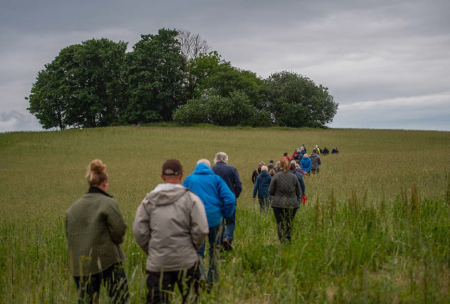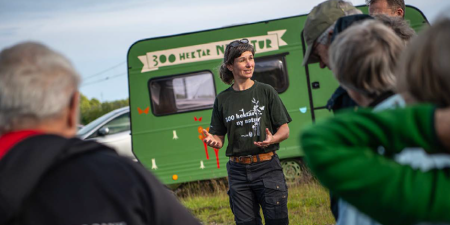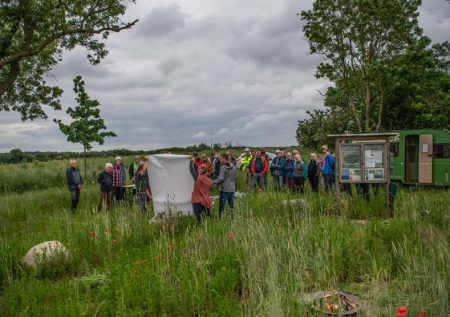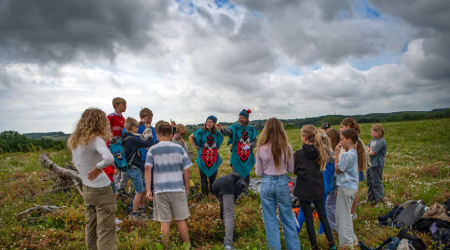
Aarhus Municipality is launching an ambitious project to transform 300 hectares of former farmland into new natural landscapes.
The initiative aims to boost biodiversity, protect groundwater, and strengthen the community’s connection to nature. Titled “300 Hectares of New Nature,” the project is not only about ecology and land use – it’s also about people. That’s why citizen engagement is a key element, with dialogue, involvement, and communication essential to building ownership and shared understanding.
From Farmland to Forest
In 2022, Aarhus City Council voted to end farming leases and convert large agricultural areas around historic estates south of the city into nature and forest. A broad political majority supported the decision, marking a major step toward Aarhus’ 2030 goal of creating 16,000 hectares of natural landscapes.
Face-to-Face Engagement
The plan also includes a strong commitment to public involvement. Projects like this affect a wide range of stakeholders – from farmers and nature enthusiasts to residents deeply connected to their local surroundings. It is vital to create inclusive forums where all voices are heard, and where knowledge-sharing and lived experiences can shape the outcome.
Based on insights from the earlier Moesgaard Vildskov rewilding project, we chose to avoid digital platforms like Facebook. In emotionally sensitive initiatives, face-to-face encounters are far more effective. Public engagement should happen within the communities – and landscapes – it affects.

The Green Caravan
That is why much of our citizen engagement happens in and around our new green caravan. More than just a mobile office, it’s a cozy, welcoming space – stocked with books, coffee pots, cookies, water, firewood, camp kettles, and even snowsuits. Atmosphere matters. When people visit the caravan to share their views on the project, they enter a space that is informal, open, and inviting.
Concerns and skepticism aren’t just welcome – they are essential starting points for meaningful dialogue. We’d much rather have those conversations early in the process than during implementation – and we’d rather have them face-to-face than through social media.
A Mobile Base for Open Dialogue
When many people show up, we move activities outside. The caravan becomes our visual anchor—a backdrop for posters, presentation boards, and discussions. We use large tarpaulin maps of the project area that can be laid out on the ground, rain or shine. Visitors are encouraged to draw, annotate, and leave comments directly on them.
We document these moments with photos and gather all questions and ideas to bring back to the project team. The caravan’s “office hours” are listed on the project website, along with City Council decisions, landscape studies, planning frameworks, and answers to frequently asked questions.

A ‘Both-And’ Approach to Landscape Heritage
Respecting local cultural heritage is central to our process. This isn’t an ‘either-or’ decision – it’s a carefully balanced ‘both-and’ approach. In practice, that means adapting our methods to each site’s unique character and history.
In some areas, we create open habitats where grazing animals help maintain semi-natural grasslands – landscapes historically shaped by estate farming. In others, we allow or support natural reforestation, for example through assisted seed dispersal. We may reintroduce stones to the landscape, disrupt drainage systems, and restore space for surface water.
Whatever tools we use, it’s essential that residents understand both the thinking behind our actions and the methods we apply.
Invited by the Locals
Over a four-month period, we spent several days each week out in the field – often combining site visits with stops in nearby villages and local grocery stores. The aim wasn’t to secure immediate agreement on future plans, but to build understanding and acceptance of the political decision already made. Without broad support, moving into the development phase could risk resistance and hinder genuine collaboration.
We concluded this phase of dialogue with three large public meetings, co-organized with local community councils. The councils took the lead on inviting participants, hosting, moderating the events, and collecting feedback. Aarhus Municipality’s project team contributed the content and technical insights.

Nature Literacy: Building Understanding and Ownership
A key part of the project is what we call ‘nature literacy’ – helping local communities build knowledge and awareness of the ecological and cultural changes taking place. We focus on communicating broader landscape dynamics, ecological restoration, and biodiversity – always grounded in the local context.
Learning from Experience
In past projects, we’ve occasionally encountered resistance when making more space for nature – especially in areas like Aarhus, where land is contested and public access highly valued. For some, giving up space and freedom of movement can be difficult.
But this project has shown something different: local citizens were willing to give space back to nature. Across interests, residents, associations, and local organizations have actively supported efforts to ensure that nature gets a strong start.
Looking Ahead: A Grounded and Shared Vision
“300 Hectares of New Nature” is more than an environmental project. It’s also a platform for collective learning – connecting people, landscapes, and cultural heritage in new ways.
We aim to deepen public understanding of the landscape and the complex choices involved in its transformation. In doing so, we hope to keep fostering meaningful, forward-looking dialogue with local communities.
This project can serve as inspiration for future nature initiatives – demonstrating how openness, trust, and dialogue help build long-term support for change.
Our approach to Citizen Engagement in the project
”300 Hectares of New Nature”:
We engage citizens in our work because everyone benefits when nature is given more space — therefore, it is essential that as many people as possible support the transformation from agriculture to nature.
We work locally:
- Local residents are actively involved
- Local knowledge institutions contribute
- Meetings are held in local buildings
- Professional initiatives are presented during field walks (e.g., drainage tours, seed dispersal, etc.)
- Information is announced locally in grocery stores, libraries, and community bulletin boards
- Updates are shared through local media and community newsletters.
We take an analogue, personal approach – and we remain accessible:
- The small green caravan serves as the Nature Office for citizens and is stationed in town squares
- Three gathering spots have been established in the fields as meeting places—each marked by a circle of ten stones and a notice board
- Leaflets tracking the project’s progress are regularly updated and made available at gathering spots and local libraries
- Workshops are conducted throughout the project period to gather input, provide feedback, and facilitate dialogue among citizens.
🔴🟡🟢 Traffic light as a tool:
Together with local residents, we have developed a tool that allows citizens to track the input received throughout the process. The project group assesses whether proposals fall within the scope of the project, lie outside of it, or require further investigation.
🟢Green:
Feasible
These proposals can be implemented within the scope of the project.
The project group may begin implementation starting in 2025.
🟡Yellow:
Possibly feasible
Pending:
• Regulatory approval
• Review by another municipal department
• Capital funding allocation
• Public meeting in November 2024
🔴Red:
Not feasible for this area due to one or more of the following reasons:
• Outside the scope of the project
• Legislation/other planning regulations
• Rejection by another municipal department